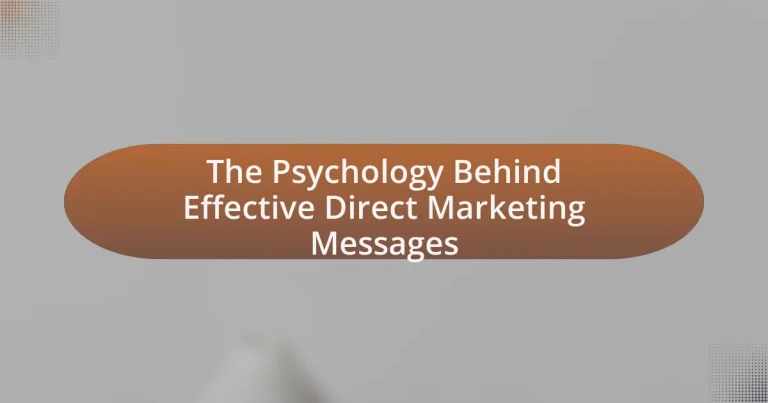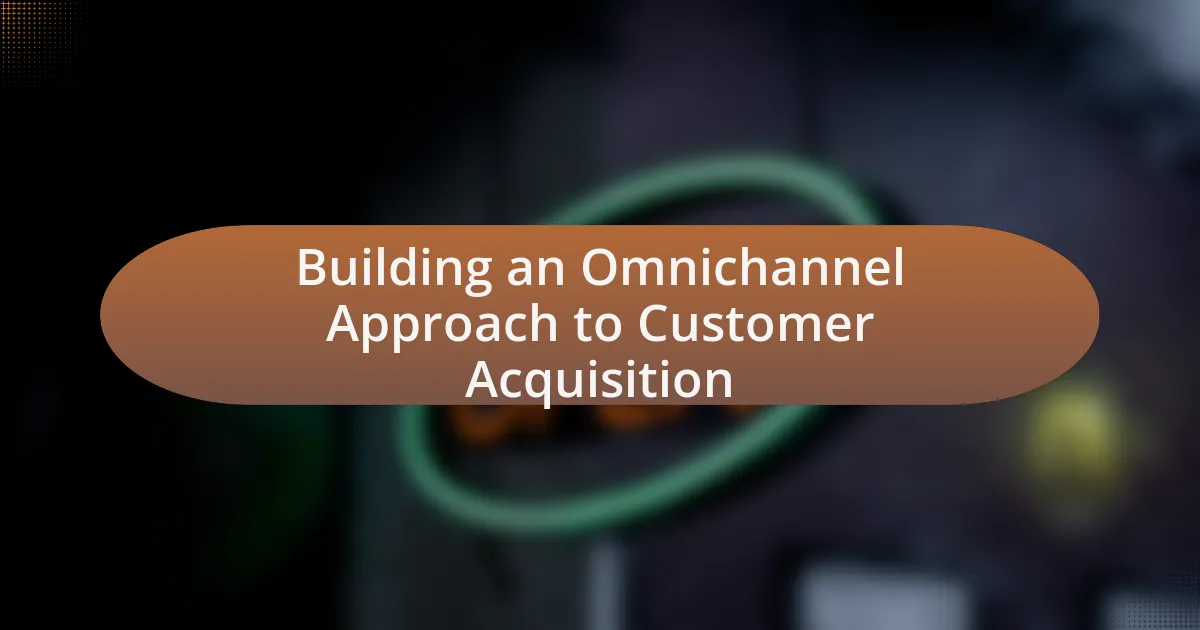The article explores the psychology behind effective direct marketing messages, emphasizing how psychological principles influence consumer behavior. It discusses key elements such as understanding target audience motivations, the impact of emotions, and the significance of psychological principles like scarcity, social proof, and reciprocity. The article highlights the importance of personalization, clarity, and strong calls to action in crafting messages that resonate with consumers, ultimately driving engagement and conversion rates. Additionally, it addresses best practices for marketers, including the use of A/B testing and the avoidance of common mistakes in direct marketing strategies.
What is the Psychology Behind Effective Direct Marketing Messages?
Effective direct marketing messages leverage psychological principles to influence consumer behavior. Key elements include understanding the target audience’s motivations, emotions, and cognitive biases. For instance, the principle of scarcity, which suggests that people value items more when they perceive them as limited, can drive urgency in purchasing decisions. Additionally, social proof, where individuals look to others’ behaviors to guide their own, can enhance credibility and encourage action. Research indicates that messages tailored to evoke specific emotions, such as happiness or fear, can significantly impact engagement and conversion rates. For example, a study published in the Journal of Consumer Research found that emotionally charged advertisements lead to higher recall and purchase intentions. Thus, effective direct marketing messages are rooted in psychological insights that resonate with consumers’ needs and behaviors.
How does psychology influence consumer behavior in marketing?
Psychology significantly influences consumer behavior in marketing by shaping perceptions, emotions, and decision-making processes. Marketers utilize psychological principles such as the scarcity effect, where limited availability increases perceived value, leading to quicker purchasing decisions. For instance, a study published in the Journal of Consumer Research found that consumers are more likely to buy products labeled as “limited edition” due to the fear of missing out. Additionally, the use of social proof, where individuals look to others’ behaviors to guide their own, can enhance trust and encourage purchases, as demonstrated by research from Cialdini, which highlights how testimonials and reviews can sway consumer choices.
What psychological principles are most relevant to direct marketing?
The psychological principles most relevant to direct marketing include reciprocity, scarcity, social proof, authority, and commitment. Reciprocity influences consumers to respond positively when they feel they have received something, such as a free sample, prompting them to reciprocate by making a purchase. Scarcity creates urgency by suggesting limited availability, which can drive consumers to act quickly. Social proof leverages the behavior of others, as people tend to follow the actions of those they perceive as similar or credible, enhancing trust in the product. Authority refers to the tendency of consumers to trust and follow recommendations from perceived experts, which can enhance the effectiveness of marketing messages. Lastly, commitment involves getting consumers to agree to a small request, which increases the likelihood of them agreeing to larger requests later, a principle known as the foot-in-the-door technique. These principles are supported by psychological research, such as Cialdini’s work on influence and persuasion, which highlights their effectiveness in shaping consumer behavior.
How do emotions play a role in consumer decision-making?
Emotions significantly influence consumer decision-making by affecting how individuals perceive products and brands. Emotional responses can create strong connections to a brand, leading to increased loyalty and preference. For instance, research by the Nielsen Company found that ads with emotional content performed about twice as well as those with purely rational content, demonstrating that feelings can drive purchasing behavior more effectively than facts alone. Additionally, emotions can trigger impulse buying; a study published in the Journal of Consumer Research indicated that positive emotions can lead to spontaneous purchases, while negative emotions may result in avoidance of certain products. Thus, understanding the emotional triggers that resonate with consumers is crucial for effective marketing strategies.
Why are effective direct marketing messages crucial for success?
Effective direct marketing messages are crucial for success because they directly influence consumer engagement and conversion rates. Research indicates that personalized messages can increase response rates by up to 29%, demonstrating that tailored communication resonates more with target audiences. Additionally, effective messaging captures attention, conveys value, and prompts action, which are essential components in driving sales and building brand loyalty. The ability to connect emotionally with consumers through well-crafted messages further enhances the likelihood of achieving marketing objectives.
What impact do well-crafted messages have on consumer engagement?
Well-crafted messages significantly enhance consumer engagement by capturing attention and fostering emotional connections. Research indicates that messages tailored to resonate with the target audience can increase response rates by up to 300%. For instance, a study by the Direct Marketing Association found that personalized marketing messages yield a 29% higher open rate compared to generic ones. This demonstrates that effective messaging not only attracts consumers but also encourages them to interact with the brand, ultimately leading to increased loyalty and sales.
How can effective messaging lead to higher conversion rates?
Effective messaging can lead to higher conversion rates by clearly communicating value propositions that resonate with the target audience. When messages are tailored to address specific needs, desires, and pain points of potential customers, they create a stronger emotional connection, which increases the likelihood of action. Research indicates that personalized messaging can boost conversion rates by up to 202%, as it makes the audience feel understood and valued. Additionally, effective messaging often employs persuasive techniques such as social proof and urgency, which further motivate consumers to make a purchase decision.
What elements contribute to the effectiveness of direct marketing messages?
The effectiveness of direct marketing messages is primarily influenced by personalization, clarity, and a strong call to action. Personalization enhances engagement by making the message relevant to the recipient, as studies show that personalized emails can increase open rates by 26%. Clarity ensures that the message is easily understood, which is crucial since 55% of consumers prefer straightforward communication. A strong call to action drives the desired response, with effective CTAs leading to conversion rates that can be up to 202% higher. These elements work together to create compelling direct marketing messages that resonate with the target audience.
How does personalization enhance direct marketing effectiveness?
Personalization enhances direct marketing effectiveness by increasing engagement and conversion rates. When marketing messages are tailored to individual preferences and behaviors, recipients are more likely to respond positively. For instance, studies show that personalized emails have a 29% higher open rate and a 41% higher click-through rate compared to generic messages. This increased relevance leads to improved customer satisfaction and loyalty, ultimately driving sales.
What techniques can be used for personalizing marketing messages?
Techniques for personalizing marketing messages include data segmentation, behavioral targeting, and dynamic content. Data segmentation involves categorizing customers based on demographics, purchase history, or preferences, allowing marketers to tailor messages to specific groups. Behavioral targeting uses customer interactions, such as website visits and purchase behavior, to deliver relevant messages at optimal times. Dynamic content enables marketers to customize email or web content in real-time based on individual user data, enhancing engagement. These techniques are supported by studies showing that personalized marketing can increase conversion rates by up to 10% and improve customer retention by 20%.
Why is audience segmentation important in direct marketing?
Audience segmentation is important in direct marketing because it allows marketers to tailor their messages to specific groups, increasing relevance and engagement. By dividing the audience based on demographics, behaviors, or preferences, marketers can create targeted campaigns that resonate more effectively with each segment. Research shows that personalized marketing can lead to a 20% increase in sales, highlighting the effectiveness of segmentation in driving consumer response.
What role does clarity and simplicity play in message effectiveness?
Clarity and simplicity are crucial for message effectiveness as they enhance comprehension and retention among the audience. When messages are clear and simple, they reduce cognitive load, allowing recipients to process information quickly and accurately. Research indicates that messages with straightforward language and structure are more likely to be understood and remembered; for instance, a study published in the Journal of Marketing Research found that clear messaging increases consumer engagement and response rates. Therefore, clarity and simplicity directly contribute to the overall impact and success of marketing communications.
How can marketers ensure their messages are clear and concise?
Marketers can ensure their messages are clear and concise by using simple language, focusing on key points, and eliminating unnecessary jargon. Research indicates that messages with fewer than 20 words are more likely to be understood and retained by the audience. Additionally, employing the “inverted pyramid” structure, where the most important information is presented first, enhances clarity. Studies show that clear messaging increases consumer engagement and response rates, demonstrating the effectiveness of these strategies in direct marketing.
What are the risks of overly complex marketing messages?
Overly complex marketing messages can lead to confusion among consumers, resulting in decreased engagement and ineffective communication. When messages are difficult to understand, potential customers may misinterpret the intended message or overlook it entirely, leading to a loss of interest in the product or service being promoted. Research indicates that clarity in messaging significantly enhances consumer comprehension and retention; for instance, a study published in the Journal of Marketing Research found that simpler messages are more likely to be remembered and acted upon. Therefore, the risk of complexity is not only a barrier to understanding but also a potential loss of sales opportunities.
How can marketers apply psychological principles to improve their direct marketing messages?
Marketers can apply psychological principles by utilizing techniques such as social proof, scarcity, and emotional appeal to enhance their direct marketing messages. Social proof, for instance, leverages the tendency of individuals to look to others for guidance, which can be demonstrated through customer testimonials or user reviews that validate the product’s effectiveness. Scarcity creates a sense of urgency by highlighting limited availability, prompting quicker decision-making among consumers. Emotional appeal taps into feelings such as happiness, fear, or nostalgia, making messages more relatable and impactful. Research indicates that messages incorporating these psychological elements can significantly increase engagement and conversion rates, as evidenced by a study published in the Journal of Consumer Research, which found that emotional advertising can lead to a 23% increase in sales compared to non-emotional approaches.
What strategies can be employed to evoke emotional responses?
To evoke emotional responses, marketers can employ strategies such as storytelling, personalization, and the use of evocative imagery. Storytelling engages audiences by creating relatable narratives that resonate with their experiences, as evidenced by research from the University of California, which found that stories can increase emotional engagement and memory retention. Personalization enhances emotional connection by tailoring messages to individual preferences and behaviors, leading to a 20% increase in response rates according to a study by Epsilon. Additionally, evocative imagery can trigger strong emotional reactions; a study published in the Journal of Consumer Research demonstrated that images that elicit nostalgia can significantly enhance consumer engagement and willingness to purchase.
How can storytelling be used to enhance marketing messages?
Storytelling can enhance marketing messages by creating emotional connections that resonate with the audience. When brands use narratives, they engage consumers on a personal level, making the message more relatable and memorable. Research indicates that stories can increase information retention by up to 65% compared to facts alone, as demonstrated in a study published in the journal “Cognitive Science” by Paul Zak, which highlights how narratives activate brain regions associated with emotion and memory. This emotional engagement leads to higher brand loyalty and increased likelihood of purchase, as consumers are more inclined to remember and share stories that evoke feelings.
What types of emotional appeals are most effective in direct marketing?
The most effective types of emotional appeals in direct marketing are fear, happiness, and belonging. Fear appeals motivate consumers by highlighting potential negative outcomes if they do not act, such as missing out on a limited-time offer. Happiness appeals evoke positive emotions, often through humor or uplifting messages, which can enhance brand perception and encourage purchases. Belonging appeals tap into the human desire for social connection, often showcasing community or group benefits associated with a product or service. Research indicates that emotional appeals significantly increase engagement and conversion rates, with studies showing that emotionally charged messages can lead to a 23% increase in sales compared to neutral messages.
How can urgency and scarcity be effectively communicated?
Urgency and scarcity can be effectively communicated by using time-sensitive language and highlighting limited availability. For instance, phrases like “limited time offer” or “only a few items left” create a sense of urgency that prompts immediate action. Research indicates that consumers are more likely to make a purchase when they perceive a risk of missing out, as demonstrated in a study published in the Journal of Consumer Research, which found that scarcity increases desirability and perceived value. By strategically employing these techniques, marketers can enhance the effectiveness of their direct marketing messages.
What are the psychological effects of urgency on consumer behavior?
The psychological effects of urgency on consumer behavior include increased motivation to purchase and a heightened sense of scarcity. When consumers perceive a limited time offer or a dwindling supply, they often experience anxiety about missing out, which can lead to impulsive buying decisions. Research indicates that urgency can trigger the fear of loss, compelling consumers to act quickly to secure a product or deal. For instance, a study published in the Journal of Consumer Research by Cialdini et al. (2006) found that consumers are more likely to make a purchase when they believe an item is in limited supply, demonstrating that urgency effectively influences decision-making processes.
How can marketers create a sense of scarcity without misleading consumers?
Marketers can create a sense of scarcity without misleading consumers by using transparent communication about limited availability. For example, they can clearly state that a product is available for a limited time or in limited quantities, ensuring that consumers understand the genuine nature of the scarcity. Research indicates that consumers respond positively to authentic scarcity, as it can enhance perceived value and urgency without deception. A study published in the Journal of Consumer Research found that when consumers are informed about actual stock levels, they are more likely to make a purchase, demonstrating that honesty in scarcity messaging fosters trust and drives sales.
What are some best practices for crafting effective direct marketing messages?
Effective direct marketing messages should be clear, concise, and targeted to the audience. Clarity ensures that the message is easily understood, while conciseness keeps the audience engaged. Targeting involves segmenting the audience based on demographics, interests, or behaviors to tailor the message specifically to their needs.
Additionally, using a strong call to action is crucial, as it directs the audience on what to do next, increasing the likelihood of conversion. Personalization enhances engagement; messages that include the recipient’s name or relevant information can significantly improve response rates.
Research indicates that personalized emails can lead to a 29% higher open rate and a 41% higher click-through rate compared to non-personalized messages, demonstrating the effectiveness of these practices.
How can A/B testing improve message effectiveness?
A/B testing improves message effectiveness by allowing marketers to compare two variations of a message to determine which one resonates better with the target audience. This method provides data-driven insights into consumer preferences, enabling marketers to optimize their messaging strategies. For instance, a study by Google found that A/B testing can lead to conversion rate improvements of up to 49% when the winning message is implemented. By systematically testing different elements such as headlines, calls to action, and visuals, marketers can refine their messages based on actual user behavior rather than assumptions, ultimately enhancing engagement and conversion rates.
What common mistakes should marketers avoid in direct marketing?
Marketers should avoid several common mistakes in direct marketing, including lack of audience segmentation, poor targeting, and unclear messaging. Lack of audience segmentation leads to generic campaigns that fail to resonate with specific consumer needs, resulting in lower engagement rates. Poor targeting can waste resources by reaching individuals who are not interested in the product or service, diminishing return on investment. Unclear messaging confuses potential customers, making it difficult for them to understand the value proposition, which can lead to missed opportunities for conversion. These mistakes can significantly hinder the effectiveness of direct marketing efforts.

















